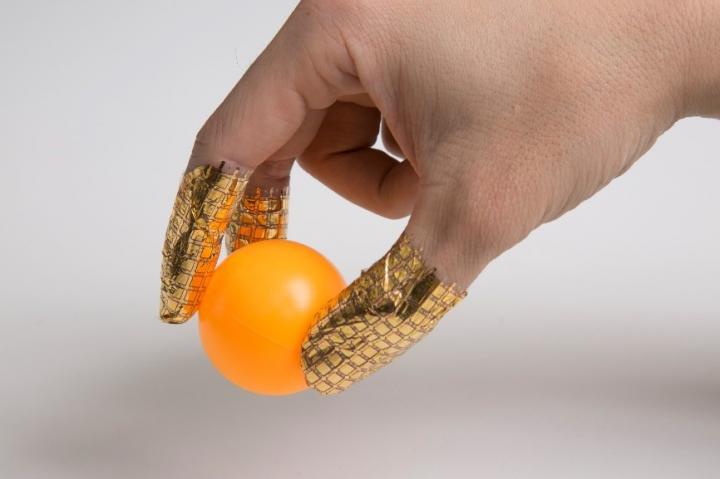Flexible and transparent pressure sensor

The pressure sensors wrap around and conform to the shape of the fingers while still accurately measuring pressure distribution. CREDIT: 2016 Someya Laboratory
Conventional pressure sensors are flexible enough to fit to soft surfaces such as human skin, but they cannot measure pressure changes accurately once they are twisted or wrinkled, making them unsuitable for use on complex and moving surfaces. Additionally, it is difficult to reduce them below 100 micrometers thickness because of limitations in current production methods.
To address these issues, an international team of researchers led by Dr. Sungwon Lee and Professor Takao Someya of the University of Tokyo's Graduate School of Engineering has developed a nanofiber-type pressure sensor that can measure pressure distribution of rounded surfaces such as an inflated balloon and maintain its sensing accuracy even when bent over a radius of 80 micrometers, equivalent to just twice the width of a human hair. The sensor is roughly 8 micrometers thick and can measure the pressure in 144 locations at once.
The device demonstrated in this study consists of organic transistors, electronic switches made from carbon and oxygen based organic materials, and a pressure sensitive nanofiber structure. Carbon nanotubes and graphene were added to an elastic polymer to create nanofibers with a diameter of 300 to 700 nanometers, which were then entangled with each other to form a transparent, thin and light porous structure.
“We've also tested the performance of our pressure sensor with an artificial blood vessel and found that it could detect small pressure changes and speed of pressure propagation,” says Lee. He continues, “Flexible electronics have great potential for implantable and wearable devices. I realized that many groups are developing flexible sensors that can measure pressure but none of them are suitable for measuring real objects since they are sensitive to distortion. That was my main motivation and I think we have proposed an effective solution to this problem.”
###
This work was conducted in collaboration with the research group of Professor Zhigang Suo at Harvard University, USA.
Journal article
Sungwon Lee, Amir Reuveny, Jonathan Reeder, Sunghoon Lee, Hanbit Jin, Qihan Liu, Tomoyuki Yokota, Tsuyoshi Sekitani, Takashi Isoyama, Yusuke Abe, Zhigang Suo, and Takao Someya, “A Transparent, Bending Insensitive Pressure Sensor,” Nature Nanotechnology,
Online edition 2016/01/25 at 16:00 London time (11:00am USA, EST)
URL: http://dx.
DOI: 10.1038/nnano.2015.324
Collaborating institutions
Osaka University
Harvard University, USA
Links
The University of Tokyo http://www.
Graduate School of Engineering http://www.
Someya Group Organic Transistor Lab http://www.
ERATO Someya Bio-Harmonized Electronics Project http://www.
Research contact
Professor Takao Someya
Department of Electrical Engineering and Information Systems
Graduate School of Engineering
The University of Tokyo, Hongo 7-3-1, Bunkyo-ku, Tokyo 113-8656, Japan
Email: someya@ee.t.u-tokyo.ac.jp
Tel: +81-3-5841-0411/6756
Fax: +81-3-5841-6709
Press officer contact
Graduate School of Engineering Public Relations Office
The University of Tokyo
The University of Tokyo, Hongo 7-3-1, Bunkyo-ku, Tokyo 113-8656, Japan
Tel: 03-5841-1790
Fax: 03-5841-0529
Email: kouhou@pr.t.u-tokyo.ac.jp
Funding
Japan Science and Technology Agency (JST) Exploratory Research for Advanced Technology (ERATO) Someya Bio-Harmonized Electronics Project
About the University of Tokyo
The University of Tokyo is Japan's leading university and one of the world's top research universities. The vast research output of some 6,000 researchers is published in the world's top journals across the arts and sciences. Our vibrant student body of around 15,000 undergraduate and 15,000 graduate students includes over 2,000 international students. Find out more at http://www.
Media Contact
All latest news from the category: Power and Electrical Engineering
This topic covers issues related to energy generation, conversion, transportation and consumption and how the industry is addressing the challenge of energy efficiency in general.
innovations-report provides in-depth and informative reports and articles on subjects ranging from wind energy, fuel cell technology, solar energy, geothermal energy, petroleum, gas, nuclear engineering, alternative energy and energy efficiency to fusion, hydrogen and superconductor technologies.
Newest articles

First-of-its-kind study uses remote sensing to monitor plastic debris in rivers and lakes
Remote sensing creates a cost-effective solution to monitoring plastic pollution. A first-of-its-kind study from researchers at the University of Minnesota Twin Cities shows how remote sensing can help monitor and…

Laser-based artificial neuron mimics nerve cell functions at lightning speed
With a processing speed a billion times faster than nature, chip-based laser neuron could help advance AI tasks such as pattern recognition and sequence prediction. Researchers have developed a laser-based…

Optimising the processing of plastic waste
Just one look in the yellow bin reveals a colourful jumble of different types of plastic. However, the purer and more uniform plastic waste is, the easier it is to…



